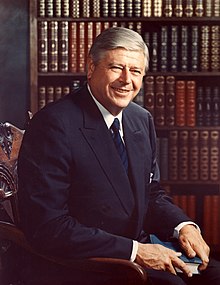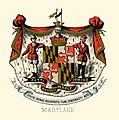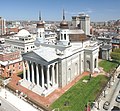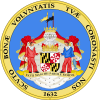|
Maryland Portal
|
Baltimore Task Force
|
Frederick Task Force
|
Montgomery Task Force
|
WikiProject Maryland
|
|
Main page
|
Discussion
|
Introduction Maryland (US: /ˈmɛrɪlənd/ MERR-il-ənd) is a state in the Mid-Atlantic region of the United States. The state borders Virginia to its south, West Virginia to its west, Pennsylvania to its north, Delaware and the Atlantic Ocean to its east, and the national capital of Washington, D.C. to the southwest. With a total area of 12,407 square miles (32,130 km2), Maryland is the ninth-smallest state by land area, and its population of 6,177,224 ranks it the 18th-most populous state and the fifth-most densely populated. Maryland's capital is Annapolis, and the most populous city is Baltimore. Occasional nicknames include Old Line State, the Free State, and the Chesapeake Bay State. It is named after Henrietta Maria, the French-born queen of England, Scotland, and Ireland during the 17th century. Maryland's coastline was first explored by Europeans in the 16th century. Prior to that, it was inhabited by several Native American tribes, mostly the Algonquian peoples and, to a lesser degree, Iroquoians and Siouans. As one of the original Thirteen Colonies, Maryland was founded by George Calvert, 1st Baron Baltimore, a Catholic convert who sought to provide a religious haven for Catholics persecuted in England. In 1632, Charles I of England granted Lord Baltimore a colonial charter, naming the colony after his wife, Henrietta Maria. Unlike the Pilgrims and Puritans, Lord Baltimore envisioned a colony where people of different religious sects would coexist under the principle of toleration. In 1649, the Maryland General Assembly passed an Act Concerning Religion, which enshrined this principle by penalizing anyone who "reproached" a fellow Marylander based on religious affiliation. Religious strife was common in Maryland's early years, and Catholics remained a minority, albeit in greater numbers than in any other English colony. Maryland's early settlements and population centers clustered around rivers and other waterways that empty into the Chesapeake Bay. Its economy was heavily plantation-based and centered mostly on the cultivation of tobacco. Demand for cheap labor from Maryland colonists led to the importation of numerous indentured servants and enslaved Africans. In 1760, Maryland's current boundaries took form following the settlement of a long-running border dispute with Pennsylvania. Maryland was an active participant in the events leading up to the American Revolution, and in 1776, its delegates to the Second Continental Congress in Philadelphia signed the Declaration of Independence. Many of its citizens subsequently played key political and military roles in the American Revolutionary War. Although it was a slave state, Maryland remained in the Union during the American Civil War, and its strategic location made it a significant strategic location during the war. After the Civil War ended, Maryland took part in the Industrial Revolution, driven by its seaports, railroad networks, and mass immigration from Europe. Since the 1940s, the state's population has grown rapidly, to approximately six million residents, and it is among the most densely populated U.S. states. , Maryland had the highest median household income of any state, owing in large part to its proximity to Washington, D.C., and a highly diversified economy spanning manufacturing, retail services, public administration, real estate, higher education, information technology, defense contracting, health care, and biotechnology. Maryland is one of the most multicultural states in the country; it is one of the six states where non-Whites compose a majority of the population, with the fifth-highest percentage of African Americans, and high numbers of residents born in Africa, Asia, Central America, and the Caribbean. The state's central role in U.S. history is reflected by its hosting of some of the highest numbers of historic landmarks per capita. (Full article...) This is a Featured article, which represents some of the best content on English Wikipedia..
William Matthews (December 16, 1770 – April 30, 1854), occasionally spelled Mathews, was an American who became the fifth Roman Catholic priest ordained in the United States and the first such person born in British America. Born in the colonial Province of Maryland, he was briefly a novice in the Society of Jesus. After being ordained, he became influential in establishing Catholic parochial and educational institutions in Washington, D.C. He was the second pastor of St. Patrick's Church, serving for most of his life. He served as the sixth president of Georgetown College, later known as Georgetown University. Matthews acted as president of the Washington Catholic Seminary, which became Gonzaga College High School, and oversaw the continuity of the school during suppression by the church and financial insecurity. Matthews was vicar apostolic and apostolic administrator of the Diocese of Philadelphia during a period of ecclesiastical turmoil. He was a co-founder and president of the Washington Library Company for thirteen years—the first public library in the District of Columbia. He also was co-director and trustee of the District of Columbia Public Schools, where he was one of the superintendents of a school. He played a significant role in the founding of Washington Visitation Academy for girls, St. Peter's Church on Capitol Hill, and the parish that now includes the Cathedral of St. Matthew the Apostle. Matthews was involved in Catholic charitable organizations as well; he was the founder and president of St. Vincent's Female Orphan Asylum and the co-founder and president of St. Joseph's Male Orphan Asylum. (Full article...)General imagesIn the news
On this day...The Maryland portal currently doesn't have any anniversaries listed for August 12. You can help by viewing the page source of an existing entry at /On this day to see how the entries should be formatted, then adding the missing entry. This is a Good article, an article that meets a core set of high editorial standards.
 Rogers Clark Ballard Morton (September 19, 1914 – April 19, 1979) was an American politician who served as the U.S. Secretary of the Interior and Secretary of Commerce during the administrations of presidents Richard Nixon and Gerald Ford, respectively. He also served as a member of the U.S. House of Representatives from Maryland. Morton was born in Louisville, Kentucky, and moved to a farm on the Eastern Shore of Maryland in the early 1950s. In 1962, he was elected to the House of Representatives, in which capacity he established a pro-environment record. Morton would joke that his two middle initials stood for "Chesapeake Bay". In 1968, Morton played a major role in Richard Nixon's campaign for president, and was chosen by Nixon in 1969 to serve as chairman of the Republican National Committee. (Full article...)Selected article -St. John's College is a private liberal arts college with campuses in Annapolis, Maryland, and Santa Fe, New Mexico. As the successor institution of King William's School, a preparatory school founded in 1696, St. John's is one of the oldest institutions of higher learning in the United States; the current institution received a collegiate charter in 1784. In 1937, St. John's adopted a Great Books curriculum based on discussion of works from the Western canon of philosophical, religious, historical, mathematical, scientific, and literary works. The college grants a single bachelor's degree in liberal arts. The awarded degree is equivalent to a double major in philosophy and the history of mathematics and science, and a double minor in classical studies and comparative literature. Two master's degrees are available through the college's graduate institute: one in liberal arts, which is a modified version of the undergraduate curriculum, and one in Eastern Classics, which applies a Great Books curriculum to a list of classic works from India, China, and Japan. (Full article...)Did you know?

SubcategoriesSelect [+] to view subcategories
TopicsRelated portalsAssociated WikimediaThe following Wikimedia Foundation sister projects provide more on this subject:
Discover Wikipedia using portals
Purge server cache
|





















































